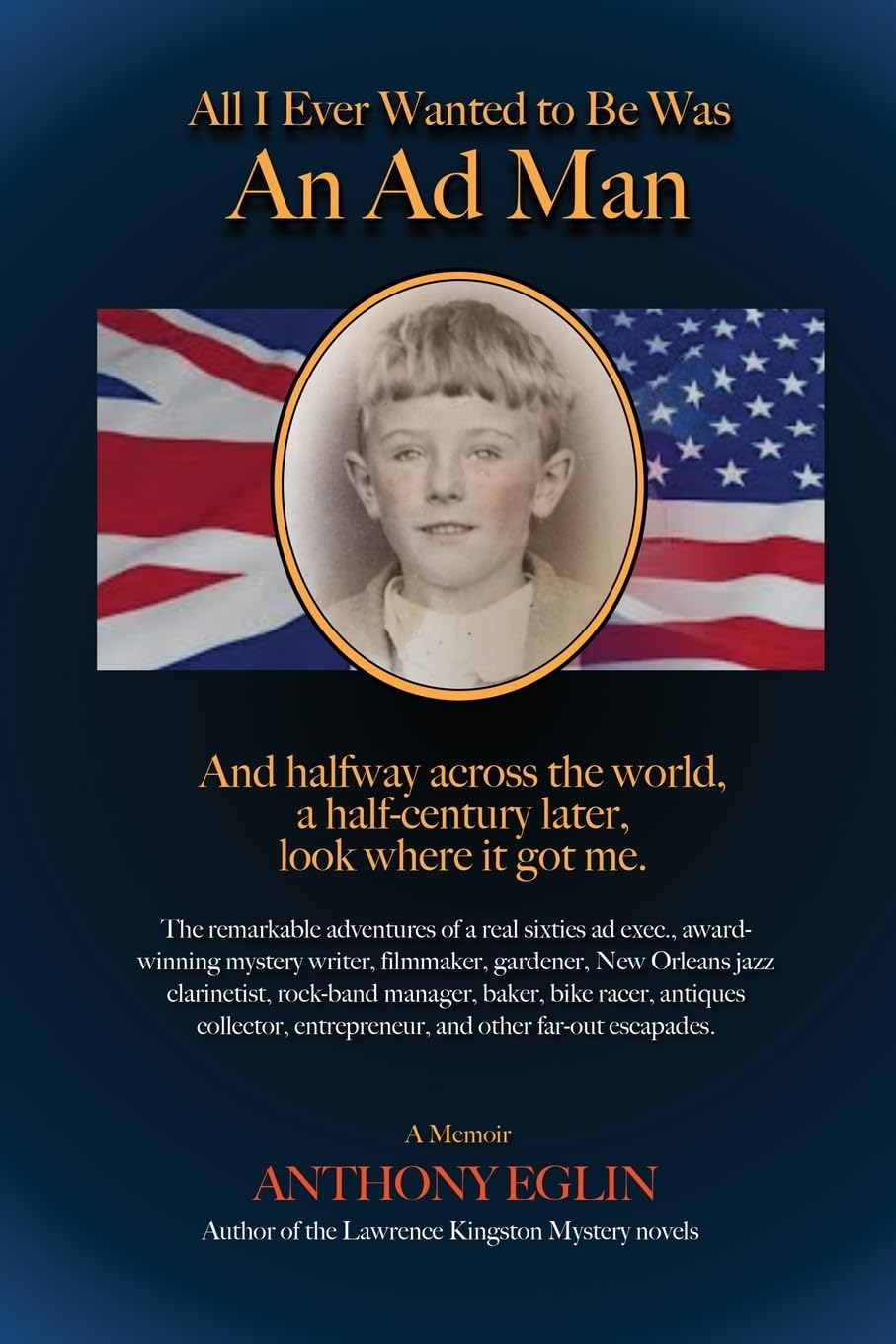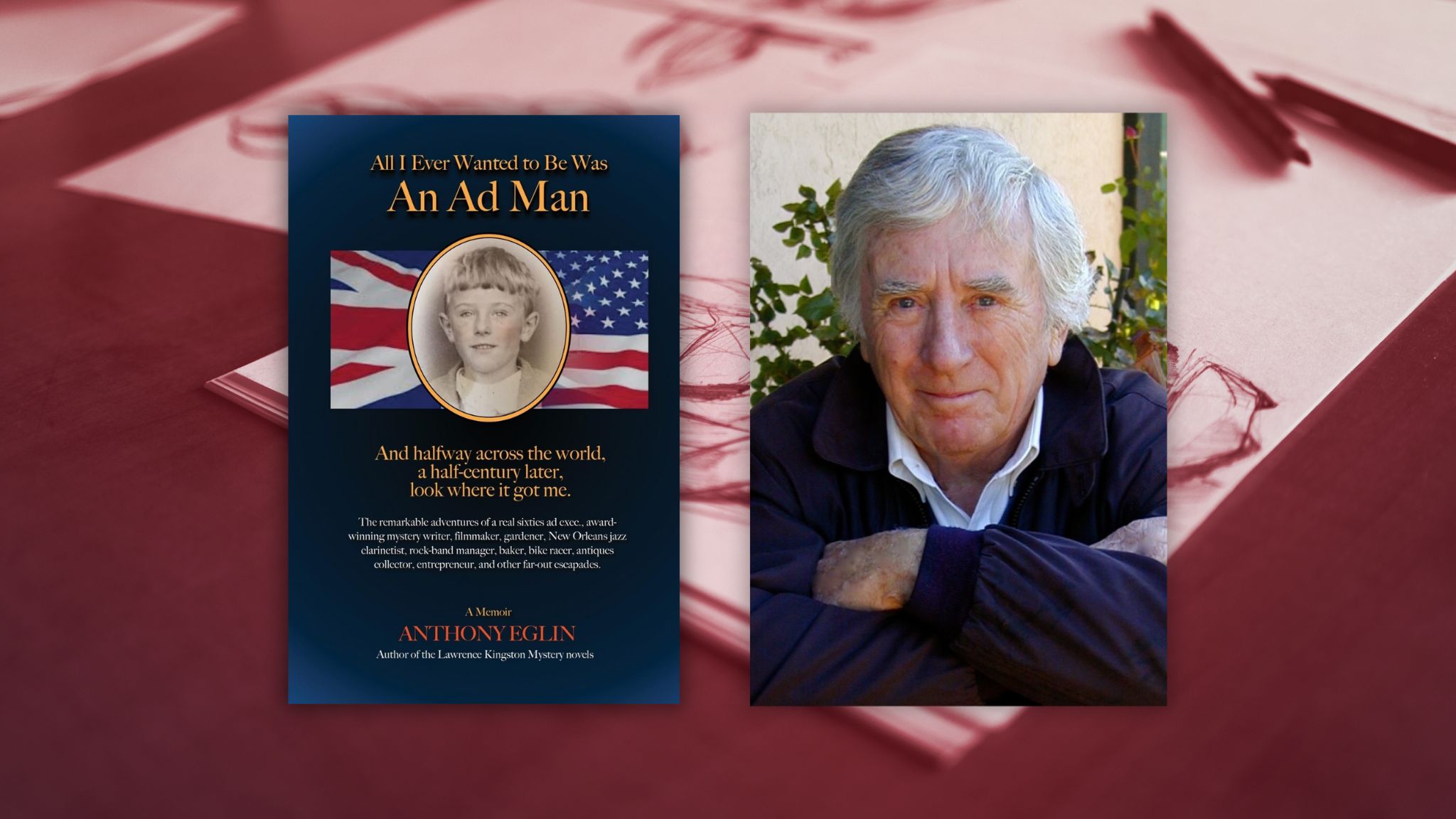All I Ever Wanted to Be Was an Ad Man by Anthony Eglin
From a childhood growing up dodging doodlebugs and bombs in wartime Britain, to an award-winning career in advertising and marketing, to a panoply of fascinating passions and pursuits, Anthony Eglin’s continent-spanning story, All I Ever Wanted to Be Was an Ad Man (Gatekeeper Press), is a heartwarming romp through the second half of the twentieth century and a captivating portrait of a life well lived.
In this recent Q&A, the author shares some anecdotes and philosophies about the ad business in particular and life in general.
Q: All you ever wanted to be was an ad man. Why was that?
A: The seed was sown when I was child in England during WWII. Often confined to the indoors, I whiled away the hours, often during nightly air raids, under the protection of our sturdy oak table, drawing with pencil on paper. With my mother’s help, I became good at it. Magazines in those days often used drawn and painted illustrations in editorial content and in advertising. So, the idea of using my budding artistic talent as a steppingstone to future employment became a dream for the future. And what better profession in which to ply my skills than the glamorous world of advertising. Even better, to set my sights on the U.S., where they were already setting new standards of excellence.
Q: What were some of the characteristics of the ad business when you were coming up the ranks, and how have those changed in today’s world?
A: One of the singular characteristics of the ad business that I perceived early on was that it was principled and fair, where you were judged only on your skills and what you could offer your employer. And there was no quick rise to the top. You had to prove yourself over time and learn what it takes to create successful ads and campaigns — that advertising is not an art, neither must ads necessarily amuse or entertain. The sole purpose of an ad or ad campaign is simple: it must sell a product or a service. Sadly, it seems that many of today’s advertising geniuses haven’t learned that lesson yet. Consider this: a 30-second TV spot in this year’s Super Bowl cost $7 million. For that obscene amount of money, don’t we deserve the very best minds and creative talent in the world?
Q: What was your most memorable story about how you dealt with a particular account?
A: The most lasting and successful in terms of top-of-the-mind awareness, brand recognition and sales, was the Armstrong Painting radio campaign. My first client Howard Fine, the owner, took a huge gamble when he hired me over several established ad agencies. My first recommendation was to revamp his media a mix of print, radio and direct mail and using radio exclusively, thereby making a much more powerful impression. While testimonial ads are a tried-and-true creative technique, I used that formula anyway. But it was the way the commercials were constructed, who voiced them, and the unforgettable, call-in phone number that made it one of San Francisco’s most successful, longest-lasting and best recall radio campaigns of all time. Believe it or not, they’re still running.
Q: Any tips for people thinking about breaking into the ad business today?
A: No matter how you slice it, advertising is really salesmanship in print and pictures. With media, the biggest changes have come with technology, the Internet and myriad social networking platforms. On the creative side, with quantum advances in computer hardware, software and now, AI. Nevertheless, it still takes a human brain to create that message; ads that will stop the readers or viewers in their tracks; to digest the copy or spoken words, and ultimately buy that product or service. A legendary ad man summed it up perfectly when he wrote: “Why people feel you have to be a writer or a painter to be creative, I’ll never understand. There are some marketing men, some heads of business I have dealt with, who are far more creative than most of the art directors and writers I know.”
Q: What was your favorite part about writing this book?
A: Even if I tried hard, it would be impossible for me to zoom in on a favorite part of the book. My life story is really less about me and more about the extraordinary cast of characters that I met along the way. Without them, there would be no story. I can’t thank them enough for the countless ways in which they all helped me, counseled and taught me, befriended me, made me laugh, and more than anything else inspired me. Any honest author will tell you that the favorite part of his or her book was when they typed the last period and wrote The End.
Q: What do you hope readers will take away from reading it?
A: As one reader commented, “Eglin’s life has more twists and turns than San Francisco’s famed Lombard Street.” So, as with a Whodunit, each reader is going to keep turning the pages to know what’s coming next. There’s enough interest, fun, entertainment, anecdotes, and adventures for everyone. However, perhaps, more than anything, it is my hope and wish that young men and women starting to make their way in life will find some insights, direction and encouragement — even inspiration — between the pages of Ad Man.
RELATED POSTS:
Inspiring Memoir About Tenacity and Ambition in Ad Man’s Ascent to Success
About Anthony Eglin:
English-born Anthony Eglin, former owner and partner of two award-winning San Francisco advertising agencies, is also the author of six British mystery novels, including The Blue Rose, judged France’s best mystery novel of 2006, and The Alcatraz Rose, an International Book Awards first-place winner. After his long career in the ad business, he wrote and directed seven award-winning documentaries featuring British Gardens, Roses, and how-to gardening shows. His former Northern California garden was winner of Garden Magazine’s Golden Trowel Award, for best U.S. Rose Garden. At home, you’ll most likely find him in his garden; if not, in the kitchen, with his talented wife Suzie, cooking up a gastronomical dish under the officious eye of their cat, Feral Frankie.





